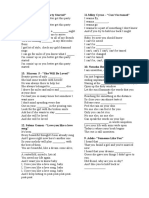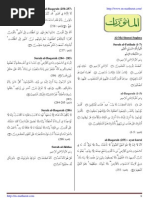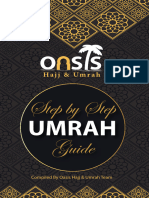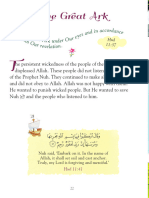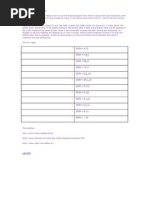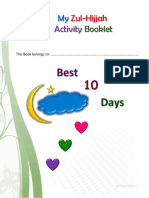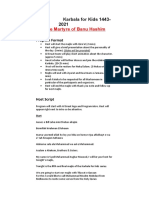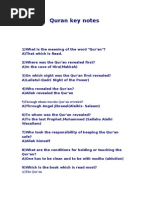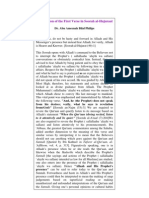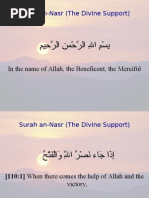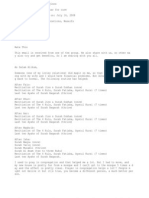0 ratings0% found this document useful (0 votes)
856 views100 Questions On Quran
100 Questions On Quran
Uploaded by
Haroon AhsanThis document contains 100 questions and answers about the Quran. Some key details include:
- There are 114 chapters (surahs) and 6,236 verses (ayahs) in the Quran.
- The Quran was revealed to the Prophet Muhammad (peace be upon him) over 22 years. The first surah was revealed in Mecca and the last in Medina.
- Important figures in preserving and compiling the Quran included Abu Bakr, Uthman, Umar, Ali, Hafs, and Aisha. Two copies of Uthman's compilation remain today in Istanbul and Tashkent.
- The Quran provides guidance on various religious practices like prayer,
Copyright:
© All Rights Reserved
Available Formats
Download as PDF, TXT or read online from Scribd
100 Questions On Quran
100 Questions On Quran
Uploaded by
Haroon Ahsan0 ratings0% found this document useful (0 votes)
856 views15 pagesThis document contains 100 questions and answers about the Quran. Some key details include:
- There are 114 chapters (surahs) and 6,236 verses (ayahs) in the Quran.
- The Quran was revealed to the Prophet Muhammad (peace be upon him) over 22 years. The first surah was revealed in Mecca and the last in Medina.
- Important figures in preserving and compiling the Quran included Abu Bakr, Uthman, Umar, Ali, Hafs, and Aisha. Two copies of Uthman's compilation remain today in Istanbul and Tashkent.
- The Quran provides guidance on various religious practices like prayer,
Original Description:
Q/A
Original Title
100 Questions on Quran
Copyright
© © All Rights Reserved
Available Formats
PDF, TXT or read online from Scribd
Share this document
Did you find this document useful?
Is this content inappropriate?
This document contains 100 questions and answers about the Quran. Some key details include:
- There are 114 chapters (surahs) and 6,236 verses (ayahs) in the Quran.
- The Quran was revealed to the Prophet Muhammad (peace be upon him) over 22 years. The first surah was revealed in Mecca and the last in Medina.
- Important figures in preserving and compiling the Quran included Abu Bakr, Uthman, Umar, Ali, Hafs, and Aisha. Two copies of Uthman's compilation remain today in Istanbul and Tashkent.
- The Quran provides guidance on various religious practices like prayer,
Copyright:
© All Rights Reserved
Available Formats
Download as PDF, TXT or read online from Scribd
Download as pdf or txt
0 ratings0% found this document useful (0 votes)
856 views15 pages100 Questions On Quran
100 Questions On Quran
Uploaded by
Haroon AhsanThis document contains 100 questions and answers about the Quran. Some key details include:
- There are 114 chapters (surahs) and 6,236 verses (ayahs) in the Quran.
- The Quran was revealed to the Prophet Muhammad (peace be upon him) over 22 years. The first surah was revealed in Mecca and the last in Medina.
- Important figures in preserving and compiling the Quran included Abu Bakr, Uthman, Umar, Ali, Hafs, and Aisha. Two copies of Uthman's compilation remain today in Istanbul and Tashkent.
- The Quran provides guidance on various religious practices like prayer,
Copyright:
© All Rights Reserved
Available Formats
Download as PDF, TXT or read online from Scribd
Download as pdf or txt
You are on page 1of 15
100 QUESTIONS ON QURAN
BISMILLAH HIRRAHMAN NIRRAHEEM
1) What is the meaning of the word "Qur'an"?
A) That which is Read.
2) Where was the Qur'an revealed first?
A) n the cave of !ira "#a$$ah).
%) &n which night was the Qur'an first revealed?
A) 'ailatul(Qadr ")ight of the *ower).
+) Who revealed the Qur'an?
A) Allah revealed the Qur'an
,) Through whom was the Qur'an revealed?
A) Through Angel -i.raeel "Alaihis(/alaam)
0) To whom was the Qur'an revealed?
A) To the last *ro1het2 #uhammed "/allahu Alaihi Wasallam).
3) Who too$ the res1onsi.ilit4 of $ee1ing the Qur'an safe?
A) Allah himself.
5) What are the conditions for holding or touching the Qur'an?
A) &ne has to .e clean and to .e with wudhu "a.lution).
6) Which is the .oo$ which is read most?
A) The Qur'an.
17) What is the to1ic of the Qur'an?
A) #an.
11) What are the other names of the Qur'an according to the Qur'an itself?
A) Al(8ur9aan2 Al(:itaa.2 Al(;i$r2 Al()oor2Al(!uda.
12) !ow man4 #a$$i /urahs "cha1ters) are there in the Qur'an?
A) 33
1%) !ow man4 #adani /urahs "cha1ters) are there in the Qur'an?
A) %3
1+) !ow man4 #an<ils "stages) are there in the Qur'an?
A) 3
1,) !ow man4 *aara or -u< "1arts) are there in the Qur'an?
A) %7
10) !ow man4 /urahs "cha1ters) are there in the Qur'an?
A) 11+
13) !ow man4 Ru$oo "1aragra1hs) are there in the Qur'an?
A) ,+7
15) !ow man4 Aa4aath "verses) are there in the Qur'an?
A) 02%0
16) !ow man4 times is the word 'Allah' re1eated in the Qur'an?
A) 2065
27) !ow man4 different t41es of Aa4aath "verses) are there in the Qur'an?
A) 17
21) Who is the first '!aafi<' of the Qur'an?
A) *ro1het #uhammed "/allalahu Alaihi Wasallam)
22) At the time of the death of *ro1het #uhammed "/allallahu Alaihi Wasallam) how
man4 !uffa< were there?
A) 22
2%) !ow man4 Aa4aath "verses) on /a=da "1rostration) are there in the
Qur'an?
A) 1+
2+) n which *aara "1art) and /urah "cha1ter) do 4ou find the first verse
a.out /a=da "1rostration)?
A) 6th *aara2 3th >ha1ter(/urah(al(Araaf2 ?erse 270.
2,) !ow man4 times has the Qur'an stressed a.out /alaat or )amaa<
"1ra4ers)?
A) 377 times.
20) !ow man4 times has the Qur'an em1hasi<ed on alms or charit4?
A) 1,7
23) !ow man4 times in the Qur'an2 is the *ro1het #uhammed "/allallahu
Alaihi Wasallam) addressed as@aa(Ai4u(!an()a.i?
A) 11 times
25) Where in the Qur'an has *ro1het #uhammed "/allallahu Alaihi Wasallam)
.een named 'Ahmed'?
A) *aara 25th2 /urah /aff2 A4ath 0th.
26) !ow man4 times has the name of Rasool(ullah "/allallahu Alaihi
Wasallam) .een mentioned in the Qur'an?
A) #uhammed "/allallahu Alaihi Wasallam) A + times B Ahmed "/allallahu
Alaihi Wasallam)(1 time.
%7) )ame the *ro1het whose name is mentioned and discussed most in the
Qur'an?
A) #oosa "Alahis(/alaam).
%1) Who were the :aati.(e(Wahi "co14ists of the revelations) of the Qur'an?
A) !a<rat A.u Ca$r "Radhiallahu Anhu)2 !a<rat Dsman "Radhiallahu Anhu)2
!a<rat Ali "Radhiallahu Anhu)2 !a<rat ;aid Cin !arith "Radhiallahu Anhu)2
!a<rat A.dullah .in #asood "Radhiallahu Anhu) B !a<rat Ameer #uawia
"Radhiallahu Anhu).
%2) Who was the first 1erson who counted the Aa4aath "verses) of the
Qur'an?
A) !a<rat A4esha "Radhiallahu Anha).
%%) &n whose advice did A.u Ca$r "Radhiallahu Anhu) decide to com1ile the
Qur'an?
A) !a<rat &mer 8aroo9 "Radhiallahu Anhu).
%+) &n whose order was the Qur'an com1iled com1letel4 in written form?
A) !a<rat A.u Ca$r "Radhiallahu Anhu).
%,) Who confined the recitation of the Qur'an on the st4le of the Qura4sh
tri.e?
A) !a<rat Dsman "Radhiallahu Anhu).
%0) &ut of the co1ies of the Qur'an com1iled .4 !a<rat Dsman "Radhiallahu Anhu)2
how man4 and where are the4 at 1resent?
A) &nl4 2 co1ies. &ne in Tash$ent and the other in stan.ul.
%3) Which /urah of the Qur'an was *ro1het #uhammed "/allallahu AlaihiWasallam)
reciting while 1ra4ing2 that !a<rat -a.eer Cin #uth'im 'istened to and em.raced
slam?
A) /urah At(Toor.
%5) Which was that /urah of the Qur'an which *ro1het #uhammed /allallahuAlaihi
Wasallam) had recited when one of his enemies Dt.a after listening to it fell in /a=da
"1rostration)?
A) The first five A4aaths of !a(#eem(/a=da "8ussilat) *ara 2+.
%6) Which is the first and the most ancient #os9ue according to the
Qur'an?
A) :aEa.a
+7) n Qur'an man$ind is divided into two grou1s. Which are those two
grou1s?
A) Celievers and dis.elievers.
+1) Who is the man a.out whom2 Allah has said in the Qur'an that his .od4
is $e1t as an admonishing eFam1le for future generations to come?
A) 8ir'aun. "*haraoh).
+2) Cesides the .od4 of *haraoh2 what is that thing which is $e1t as an
admonishing eFam1le for future generations to come?
A) )oah's Ar$.
+%) After the wrec$age of *ro1het )oah's Ar$2 which is its 1lace of rest mentioned in
the Qur'an?
A) >ave of -udi.
++) n the Qur'an the name of which com1anion of *ro1het #uhammed"/allallahu
Alaihi Wasallam) is mentioned?
A) !a<rat ;aid Cin !arith "Radhiallahu Anhu) "/urah A Al(Ah<a.) /urah G %%2 A4at G
%3.
+,) Who is the relative of the *ro1het #uhammed "/allallahu Alaihi Wasallam) whose
name is mentioned in the Qur'an?
A) A.u 'aha. "/urah Al(#asadd) /urah G 1112 *ara %7.
+0) n the Qur'an there is a mention of a *ro1het who has .een called .4 his
mother's name. Who was he?
A) -esus !a<rat sa "Alahis salaam) is mentioned as .n #ar4am.
+3) Which was the agreement that was titled as H8ath(hum(#u.een' without fighting
a .attle?
A) Treat4 of !udai.i4a "/ulhe !udai.i4a).
+5) What are the different names used for /atan or Ievil in the Qur'an?
A) .lees and Ash(/haitaan.
+6) Which categor4 of creature does the Qur'an 1ut '.lees' into?
A) -inn.
,7) What were those worshi1s and 1ra4ers that were ordered .4 Allah to the
>ommunit4 of Cani srael and which were continued for the #uslim Dmmah
also?
A) /alaat "*ra4ers) and ;a$aat. "Al(Ca9arahJ+%)
,1) The Qur'an re1eatedl4 warns of a certain da4. Which da4 it is?
A) @aumul Qi4amah."The Ioomsda4).
,2) Who were those 1eo1le with whom Allah was 1leased and the4 were 1leased
with !im2 as mentioned in the Qur'an?
A) >om1anions K /aha.a "Radhiallahu Anhum) of our .eloved *ro1het
#uhammed."/allallahu Alaihi Wasallam).
,%) n which !ol4 Coo$ of )on(#uslims the Qur'an is mentioned re1eatedl4?
A) n the !ol4 Coo$ of /i$h >ommunit4(Lranth /ahe..
,+) n which 4ear were the vowels inserted in the Qur'an?
A) +% !i=ri.
,,) Who were the first serious students of the Qur'an?
A) Ashaa.us /uffah "/tudents who used to sit at a 1lace in
#as=id(e()a.vi /AW).
,0) Which is the first Residential Dniversit4 where the facult4 of the
Qur'an was esta.lished for the first time?
A) #as=id(e()a.vi.M#os9ue of the *ro1het "/allallahu Alaihi Wasallam).
,3) C4 what name did the Qur'an address those no.le and 1ious 1eo1le who
were selected .4 Allah to conve4 !is message to man$ind?
A) )a.i "*ro1het) and Rasool "#essenger).
,5) What t41e of a 1erson does the Qur'an want to ma$e?
A) #omin.
,6) What is the scale or measure of one's dignit4 according to the Qur'an?
A) Ta9wa. "*iet4)
07) What according to the Qur'an is the root cause of the evil?
A) Alcohol.
01) What are the two most im1ortant t41es or $inds of Aa4aath "?erses)found
in the Qur'an?
A) #uha$$amaat and #utasha.ihaath "&rders K nstructions and NFam1les
K nstances ( lessons).
02) Which is the longest /urah ">ha1ter) in the Qur'an?
A) /urah(al(Ca9arah A /urah G 2.
0%) Which is the smallest /urah in the Qur'an?
A) /urah(al(:ausar A /urah G 175.
0+) What was the age of *ro1het #uhammed "/allallahu Alaihi Wasallam) when
Qur'an was first revealed to him through !a<rat -i.raeel "Alaihis(salaam)?
A) +7 @ears.
0,) !ow long did *ro1het #uhammed "/allallahu Alaihi Wasallam) receive the
revelation of the Qur'an in #a$$ah?
A) 1% @ears.
00) !ow long did *ro1het #uhammed "/allallahu Alaihi Wasallam) receive the
revelation of the Qur'an in #adinah?
A) 17 @ears.
03) Where was the first /urah revealed?
A) n #a$$ah.
05) Where was the last /urah revealed?
A) n #adinah.
06) !ow man4 4ears did it ta$e for the com1lete revelation of the Qur'an?
A) 22 4ears2 , months and 1+ da4s.
37) Which /urah ">ha1ter) of the Qur'an is to .e read com1ulsoril4 in each
ra$a'at of the /alat ")amaa<)?
A) /urah(al(8atihah "The &1ening) A /urah G 1.
31) Which is the /urah2 which Allah taught as a Iu'a "*ra4er)?
A) /urah(al(8atihah "The &1ening) A /urah G 1.
32) What is the reason of $ee1ing /urah(al(8atihah in the .eginning of the Qur'an?
A) t is the door to the Qur'an.
3%) What is the /urah ">ha1ter) revealed com1letel4 and found first 1lace
in the Qur'an?
A) /urah(al(8atihah "The &1ening) A /urah G 1.
3+) Who was the onl4 lad4 whose 1ersonal name is found in the Qur'an?
A) #ariam "Alaihis(salaam).
3,) n which /urah ">ha1ter) of the Qur'an do 4ou find maFimum instructions?
A) /urah(al(Ca9arah A /urah G 2.
30) When and Where did the *ro1het #uhammed /allallahu Alaihi Wasallam) and
!a<rat -i.raeel "Alaihis(salaam) meet for the second time?
A) &n 8rida4215th Ramadan2in the >ave of !ira.
33) What was the interval .etween the first and the second revelation?
A) 2 4ears and siF months.
35) Which is the /urah ">ha1ter) that does start without Cismillah?
A) /urah(al(Tau.ah or Cara'ath A /urah G 6.
36) n which /urah ">ha1ter) of the Qur'an Cismillah is re1eated twice?
A) /urah(al )aml A /urah G 23.
57) !ow man4 /urahs ">ha1ters) in the Qur'an have the titles named after
different *ro1hets?
A) 0 /urahs ">ha1ters)J
a) /urah(al(@unus A /urah G 17.
.) /urah(al(!ood A /urah G 11.
c) /urah(al(@usuf A /urah G 12.
d) /urah(al(.raheem A /urah G 1+.
e) /urah(al(#uhammed A /urah G +3.
f) /urah(al()uh A /urah G 31.
51) n which 1art of the Qur'an do 4ou find 'A4at(ul(:ursi' "?erse of the
Throne)?
A) n the .eginning of the third *art ."/urah G 22 A4at G 2,,).
52) !ow man4 different names of Allah are mentioned in the Qur'an?
A) 66
5%) Who were the three non(1ro1hets whose names are mentioned with due
res1ect in the Qur'an?
A) 'u9man2 A<i< of Ng41t and ;ul9arnain.
5+) At the time of !a<rat A.u Ca$r "Radhiallahu Anhu) how man4 com1anions
had com1iled the Qur'an in the form of a .oo$?
A) 3, com1anions.
5,) Which is the onl4 .oo$ that is com1letel4 memori<ed .4 millions of
1eo1le in the world?
A) Al(Qur'an.
50) What did the -inns who heard a few Aa4aath ?erses) of the Qur'an sa4 to
each other?
A) We have heard a uni9ue discourse which shows the right 1ath2 veril4
we .elieve in it.
53) Which are the most 1o1ular translations of the Qur'an in Nnglish?
A) Translation .4 #uhammed #armadu$e *ic$thall and .4 Allama @usuf Ali.
55) nto how man4 languages of the world has the !ol4 Qur'an .een
translated?
A) )earl4 17% languages.
56) Who was the first translator of the !ol4 Qur'an into Drdu?
A) #oulana /hah Rafiuddin #uhaddis Iehlavi.
67) What will .e our condition on 'The da4 of the -udgment' according to
the Qur'an?
A) Nver4.od4 will .e in a state of anFiet4.
61) Who was the *ro1het mentioned in the Qur'an whose three generations
were 1ro1hets?
A) !a<rat .raheem "Alaihis(salaam).
62) What is that .oo$ which a.olished all old rules and regulations?
A) Al(Qur'an.
6%) What does the Qur'an sa4 a.out 1ro1ert4 and wealth?
A) The4 are tests of one's faith.
6+) According to the Qur'an who is "$haatamun )a.i44een" "the last of the
*ro1hets)?
A) *ro1het #uhammed "/allallahu Alaihi Wasallam)
6,) What is the name of the .oo$ that tells us clearl4 a.out the realit4 of
the .eginning and the end of the world?
A) Al(Qur'an.
60) n the Qur'an what other name is given to the cit4 of #a$$ah?
A) Ca$$ah and Caladul Ameen.
63) According to the Qur'an what other name is given to the cit4 of #adinah?
A) @athri..
65) Whose Leneration is $nown as "Cani srael" according to the Qur'an?
A) The generation of *ro1het @a9oo. "Alaihis salaam) who is also $nown as srael.
66) Which are the mos9ues that are mentioned in the Qur'an.
a) #as=id(ul(!aram A #a$$ah A /urah G 132 ?erse G 1 1lus man4 other verses
in the Quran.
.) #as=id(ul(;irar A #adinah "This mos9ue was .uilt .4 #unafi9een K !41ocrites in
front of #as=id(e(Qu.a) A /urah G 62 ?erse G 173.
c) #as=id(ul()a.awi ( #adinah. ???
d) #as=id(ul(A9sa A *alestine A /urah G 132 ?erse G 1.
e) #as=id Qu.a A #adinah A /urah G 62 ?erse G 175.177) The name of which angels
are mentioned in the Qur'an?
a) !a<rat -i.raeel Ameen. "Alaihis salaam)
.) !a<rat #ee$aeel. "Alaihis salaam)
c) !a<rat !aroot. "Alaihis salaam)
d) !a<rat #aroot. "Alaihis salaam)
The word .ird is mentioned in the Llorious Quran , times and the word .irds occur in
the )o.le Quran 1% times. Among the .irds2 the hoo1oe "hud(hud in Ara.ic) has
.een s1ecificall4 mentioned twice in /urah G 232 An()aml2 the following mannerJ
OAnd he sought among the .irds and saidJ !ow is it that see not the hoo1oe2 or is
he among the a.sent?P /urah 23J27 "?erse).Q R R
*rominent scholar Ir. !amidullah tells of an effort in Lerman4 .4 the >hristian
scholars to gather all the Lree$ manuscri1ts of Ci.le as the original Ci.le in Aramaic
is eFtinct. The4 gathered all manuscri1ts in the world and after eFamining them
re1ortedJ "/ome two hundred thousand contradictor4 narrations have .een found...
of these one(eighth are of an im1ortant nature.
" When the re1ort was 1u.lished2 some 1eo1le esta.lished an nstitute for Qur'anic
Research in #unich with the goal of eFamining Qur'an the same wa4. A gigantic
research 1ro=ect was started that continued for three generations.
C4 16%%2 +%777 1hotoco1ies of Qur'anic manuscri1ts had .een collected. A re1ort
1u.lished shortl4 .efore World War showed the results of the eFamination of these
manuscri1ts. While some minor mista$es of calligra1h4 were found2 not a single
discre1anc4 in the teFt had .een discoveredS
&f course the love2 devotion and care that #uslim showed toward the Qur'an2 and
that .ecame the immediate cause of its miraculous 1reservation2 was ins1ired .4 the
*ro1het #uhammad2 /alla(Allahu ala4hi wa sallam. &n one occasion he as$ed the
com1anions in /uffaJ Which of 4ou would li$e to goout ever4 morning to Cuthan or
Al( A9i9 "two mar$ets near #edina) and .ring two large she(camels without .eing
guilt4 of sin or without severing the ties of $inshi1? >amels were the valua.le
commodit4 of the time2 she(camels even more so. ts e9uivalent toda4 ma4 .e a
.rand new automo.ile. As the4
showed their interest2 *ro1het #uhammad2 /alla(Allahu ala4hi wa sallam2 eF1lainedJ
To teach or recite two verses of the Qur'an is .etter than getting two she(camels.
And three verses are .etter than three she(camels. "#uslim).
And so2 for centuries this ummah dis1la4ed an un1recedented love and devotion for
the Coo$ of Allah. t .egan the education of its children .4 teaching them how to
read Qur'an. t .egan its da4 .4 reciting from the Qur'an. Qur'an was divided into
seven 1arts2 each called a man<il2 so it could .e read com1letel4 ever4 wee$. t was
divided into thirt4 1arts2 each called a =u<2 so it could .e read com1letel4 ever4
month. Qur'an is the most read and memori<ed .oo$ in the worldS
Toda42 though2 we see a change. Than$s to the twin scourges of a colonial education
s4stem and the television2 toda4 we find millions of #uslim children for whom
learning to read the Qur'an is not 1art of their education. We find millions of #uslim
homes where Qur'an is read onl4 on s1ecial occasions.
When someone dies2 for eFam1le. This des1ite the fact that in most 1arts of the
world toda42 unli$e the /oviet Dnion of 4esterda42 reading the Qur'an is no longer a
high ris$ 1ro1osition. !ow unfortunate is the 1erson who should die of thirst while
holding the refreshing glass of water in his handsS !ow unfortunate the 1erson who
should die of disease while holding the 1erfect medicine in his handsS&f course we
must read it2 understand it2 and 1ut it into 1ractice.
Cut we must also remem.er that reading with full deference and 1ro1er eti9uettes is
a 1re(re9uisite for understanding the Qur'an2 =ust as understanding its message is a
1re(re9uisite for 1racticing it. &ur goal must .e to live .4 the Qur'an. 8or onl4 then
we trul4 live. &therwise we onl4 1retend to live.
A''A! !A8;
HOLY QURAN 50 Questions & Answers
50 Questions & Answers on The Quran
1 !hat is the "eanin# o$ the wor% &Qur'an&(
A That whi)h is Rea%*
+ !here was the Qur'an re,ea-e% $irst(
A In the )a,e o$ Hira .Ma//ah
0 On whi)h ni#ht was the Qur'an $irst re,ea-e%(
A Lai-atu-1Qa%r .Ni#ht o$ the 2ower
3 !ho re,ea-e% the Qur'an(
A A--ah re,ea-e% the Qur'an
5 Throu#h who" was the Qur'an re,ea-e%(
A Throu#h An#e- 4i5raee- .A-aihis1Sa-aa"
6 To who" was the Qur'an re,ea-e%(
A To the -ast 2ro7het8 Muha""e% .Sa--ahu A-aihi !asa--a"
9 !ho too/ the res7onsi5i-it: o$ /ee7in# the Qur'an sa$e(
A A--ah hi"se-$
; !hat are the )on%itions $or ho-%in# or tou)hin# the Qur'an(
A One has to 5e )-ean an% to 5e with wu%hu .a5-ution
< !hi)h is the 5oo/ whi)h is rea% "ost(
A The Qur'an
10 !hat is the to7i) o$ the Qur'an(
A Man
11 !hat are the other na"es o$ the Qur'an a))or%in# to the Qur'an itse-$(
A A-1=ur>aan8 A-1?itaa58 A-1@i/r8 A-1Noor8A-1Hu%a
1+ How "an: Ma//i Surahs .)ha7ters are there in the Qur'an(
A ;6
10 How "an: Ma%ani Surahs .)ha7ters are there in the Qur'an(
A +;
13 How "an: ManAi-s .sta#es are there in the Qur'an(
A 9
15 How "an: 2aara or 4uA .7arts are there in the Qur'an(
A 00
16 How "an: Surahs .)ha7ters are there in the Qur'an(
A 113
19 How "an: Ru/oo .7ara#ra7hs are there in the Qur'an(
A 530
1; How "an: Aa:aath .,erses are there in the Qur'an(
A 6666
1< How "an: ti"es is the wor% 'A--ah' re7eate% in the Qur'an(
A +6<;
+0 How "an: %i$$erent t:7es o$ Aa:aath .,erses are there in the Qur'an(
A 10
+1 !ho is the $irst 'Haa$iA' o$ the Qur'an(
A 2ro7het Muha""e% .Sa--a-ahu A-aihi !asa--a"
++ At the ti"e o$ the %eath o$ 2ro7het Muha""e% .Sa--a--ahu A-aihi
asa--a"how "an: Hu$$aA were there(
A ++
+0 How "an: Aa:aath .,erses on SaB%a .7rostat ion are there in the
Qur'an(
A 13
+3 In whi)h 2aara .7art an% Surah .)ha7ter %o :ou $in% the $irst ,erse
a5out SaB%a 7rostation (
A <th 2aara8 9th Cha7ter1Surah1 a-1Araa$8 Derse +06
+5 How "an: ti"es has the Qur'an stresse% a5out Sa-aat or Na"aaA
.7ra:er(
A 900 ti"es
+6 How "an: ti"es has the Qur'an e"7hasiAe% on a-"s or )harit:(
A 150
+9 How "an: ti"es in the Qur'an8 is the 2ro7het Muha""e% .Sa--a--ahu
A-aihi !asa--a" a%%resse% asYaa1Ai:u1Han1 Na5i(
A 11 ti"es
+; !here in the Qur'an has 2ro7het Muha""e% .Sa--a--ahu A-aihi
!asa--a"5een na"e% 'Ah"e%'(
A 2aara +;th8 Surah Sa$$8 A:ath 6th
+< How "an: ti"es has the na"e o$ Rasoo-1u--ah .Sa--a--ahu A-aihi
!asa--a" 5een "entione% in the Qur'an(
A Muha""e% .Sa--a--ahu A-aihi !asa--a"13ti"es Ah"e% .Sa--a--ahu A-aihi
!asa--a"11 ti"e
00 Na"e the 2ro7het whose na"e is "entione%an% %is)usse% "ost in the
Qur'an(
A Moosa .A-ahis1Sa-aa"
01 !ho were the ?aathi5e1!ahi .)o7:ists o$ the re,e-ations o$ the
Qur'an(
A A5u Ba/r .Ra%hia--ahu Anhu8 Us"an .Ra%hia--ahu Anhu8 A-i
.Ra%hia--ahu Anhu8 @ai% Bin Harith.Ra%hia--ahu Anhu An% A5%u--ah 5in
Masoo%.Ra%hia--ahu Anhu
0+ !ho was the $irst 7erson who )ounte% the Aa:aath .,erses o$ the
Qur'an(
A A:esha .Ra%hia--ahu Anha
00 On whose a%,i)e %i% A5u Ba/r .Ra%hia--ahu Anhu %e)i%e to )o"7i-e the
Qur'an(
A O"er =aroo>.Ra%hia--ahu Anhu
03 On whose or%er was the Qur'an )o"7i-e% )o"7-ete-: in written $or"(
A A5u Ba/r .Ra%hia--ahu Anhu
05 !ho )on$ine% the re)itation o$ the Qur'an on the st:-e o$ the Qura:sh
tri5e(
A Us"an .Ra%hia--ahu Anhu
06 Out o$ the )o7ies o$ the Qur'an )o"7i-e% 5: Us"an .Ra%hia--ahu Anhu8
how "an: an% where are the: at 7resent(
A On-: + )o7ies* One in Tash/ent an% the other in Istan5u-*
09 !hi)h Surah o$ the Qur'an was 2ro7het Muha""e% .Sa--a--ahu A-aihi
!asa--a" re)itin# whi-e 7ra:in#8 that HaArat 4a5eer Bin Muth'i" Listene%
to an% e"5ra)e% Is-a"(
A Surah Thoor
0; !hi)h was that Surah o$ the Qur'an whi)h the 2ro7het Muha""e%
.Sa--a--ahu A-aihi !asa--a" ha% re)ite% when one o$ his ene"ies Ut5a a$ter
-istenin# to it $e-- in SaB%a .7rostation (
A The $irst $i,e A:aaths o$ Ha"1Mee"1SaB%a
0< !hi)h is the $irst an% the "ost an)ient Mos>ue a))or%in# to the Qur'an
A ?aa5a
30 In Qur'an "an/in% is %i,i%e% into two #rou7s*!hi)h are those two
#rou7s(
A Be-ie,ers an% %is5e-ie,ers
31 !ho is the "an a5out who"8 A--ah has sai% in the Qur'an that his 5o%:
is /e7t as an a%"onishin# eEa"7-e $or $uture #enerations to )o"e(
A =ir'aun* .2haraoh
3+ Besi%es the 5o%: o$ 2haraoh8 what is that thin# whi)h is /e7t as an
a%"onishin# eEa"7-e $or $uture #enerations to )o"e(
A Noah's Ar/*
30 A$ter the wre)/a#e o$ 2ro7het Noah's Ar/8 whi)h is its 7-a)e o$ rest
"entione% in the Qur'an(
A Ca,e o$ 4u%i*
33 In the Qur'an the na"e o$ whi) h )o"7anion o$ 2ro7het Muha""e%
.Sa--a--ahu A-aihi !asa--a" is "entione%(
A @ai% Bin Harith*
35 !ho is the re-ati,e o$ the 2ro7het Muah""e% .Sa--a--ahu A-aihi
!asa--a"whose na"e is "entione% in the Qur'an(
A A5u Laha5
36 In the Qur'an there is a "ention o$ a 2ro7het who has 5een )a--e% 5: his
"other's na"e* !ho was he(
A 4esus F2ro7het Isa .A-ahis sa-aa"G is "entione% as 5in Mar:a"*
39 !hi)h was the a#ree"ent that was tit-e% =ath1hu"1Mu5een' without
$i#htin# a 5att-e(
A Treat: o$ Hu%ai5i:a
3; !hat are the %i$$erent na"es use% $or Satan or He,i- in the Qur'an(
A I5-ees an% Ash1Shaitaan*
3< !hi)h )ate#or: o$ )reature %oes the Qur'an 7ut 'I5-ees' into(
A 4inn*
50 !hat were those worshi7s an% 7ra:ers that were or%ere% 5: A--ah to
the )o""unit: o$ Bani Israee- an% whi)h were )ontinue% 5: the Mus-i"
U""ah a-so(
A Sa-aat an% @a/aat* .A-1Ba>arahI 30
JJJJJJJJJJJJJJJJJJJJJJJJJJJJJJJJJJJJJJJJJJJJJJJJJJ
JJJJJJJJJJJJJ
HUA =OR STRENKTHENINK BRAIN
LRa55ishrah-ee swathiree Da:assir-ee a"ree Dah-u- u>%hathan "in -isanee
Ya$>ahoo >au-ee
" #4 'ord2 eF1and "i.e.2 relaF) for me m4 .reast "with assurance) And ease for me
m4 tas$ And untie the $not from m4 tonge That the4 ma4 understand m4
s1eech""Qur'An 27J2,(25)
You might also like
- Good Questions To Choose From For Children Islamic Quiz.: Page 1 of 11Document11 pagesGood Questions To Choose From For Children Islamic Quiz.: Page 1 of 11Thanveer100% (3)
- Kids Ramadan Journal Blue DotDocument35 pagesKids Ramadan Journal Blue Doth_khatimah100% (1)
- What Does Tawheed Mean in The Linguistic SenseDocument5 pagesWhat Does Tawheed Mean in The Linguistic SenseAdriana CurcaNo ratings yet
- Revision Worksheet - 1 Grade 5 Islamic Studies 2021Document2 pagesRevision Worksheet - 1 Grade 5 Islamic Studies 2021Fallon Clips100% (1)
- Islamic Studies WorksheetsDocument2 pagesIslamic Studies WorksheetsEhab Islam100% (1)
- Madd TestDocument2 pagesMadd TestIbn FulaanNo ratings yet
- When The Moon Split Questions Chap 1-5Document9 pagesWhen The Moon Split Questions Chap 1-5Nabil Mosharraf Hossain100% (2)
- Lessonplans KG To Grade 13 Islamic Studies v5Document22 pagesLessonplans KG To Grade 13 Islamic Studies v5Mohd Fadhly100% (1)
- Islamic Studies Grade 01Document164 pagesIslamic Studies Grade 01KazeemNo ratings yet
- 100 Questions On The QuranDocument8 pages100 Questions On The QuranSyed Ahtasham ul haq100% (2)
- Pasive in SongsDocument5 pagesPasive in SongsTeacher IreneNo ratings yet
- Al-Mathurat Sughra - Ringkas - M-Mathurat HTTP://FB - Mmathurat/comDocument3 pagesAl-Mathurat Sughra - Ringkas - M-Mathurat HTTP://FB - Mmathurat/comKhirulnizam Abd Rahman78% (32)
- Fiqh Worksheets WDocument10 pagesFiqh Worksheets Wapi-243967076No ratings yet
- Urdu Hand Writing Worksheet For Grade 2Document5 pagesUrdu Hand Writing Worksheet For Grade 2apview123100% (1)
- Grade V Unit # 7 PracticeDocument4 pagesGrade V Unit # 7 PracticeHameed RehmanNo ratings yet
- ULA Resource Pack (Urdu Version)Document70 pagesULA Resource Pack (Urdu Version)Ayesha chaudharyNo ratings yet
- 114 NaasDocument24 pages114 Naassaoodhashim903No ratings yet
- Islamic Studies Grade 7 ReviewDocument6 pagesIslamic Studies Grade 7 Reviewapi-299773823No ratings yet
- Diniyat Book 5Document222 pagesDiniyat Book 5Yasir AbbasNo ratings yet
- G3 - Islamic Studies Revision Worksheets (May 2011)Document5 pagesG3 - Islamic Studies Revision Worksheets (May 2011)ManaratPrimary100% (1)
- Grade 1 Islamic Studies RevisionDocument8 pagesGrade 1 Islamic Studies RevisionKhizar HayatNo ratings yet
- Umrah Guide: A Simple Yet Comprehensive PocketsizeDocument64 pagesUmrah Guide: A Simple Yet Comprehensive PocketsizeShazia HamidNo ratings yet
- Aqeedah of Tawheed Ebook W ArabicDocument11 pagesAqeedah of Tawheed Ebook W Arabicdarkmc667No ratings yet
- (Going To Sleep) : Sahih Al Bukhari & MuslimDocument24 pages(Going To Sleep) : Sahih Al Bukhari & MuslimNada SyedNo ratings yet
- Kids Quiz - The Prophets of Allah Part Two by WWW - Arabicfirst.co - UkDocument11 pagesKids Quiz - The Prophets of Allah Part Two by WWW - Arabicfirst.co - UkMountainofknowledgeNo ratings yet
- Learn Noorani QaidaDocument6 pagesLearn Noorani QaidaDSGGGGENo ratings yet
- Islamiat Summer Vacation Homework by Abdullah SufianDocument17 pagesIslamiat Summer Vacation Homework by Abdullah SufianMoon boyNo ratings yet
- LMP English (Ok)Document2 pagesLMP English (Ok)Sal RaufNo ratings yet
- Simplified Islamic Quiz Abubakr Amosa Ladi IbraheemDocument83 pagesSimplified Islamic Quiz Abubakr Amosa Ladi IbraheemDe EagleMedia PicturesNo ratings yet
- Dictionary of The QuranDocument881 pagesDictionary of The QuranBooks for IslamNo ratings yet
- Grade 2 SpokenDocument56 pagesGrade 2 Spokenm8pjymspypNo ratings yet
- Ramadhan-Workbook 2 - 1Document24 pagesRamadhan-Workbook 2 - 1api-455002776No ratings yet
- Quran Lessons For KidsDocument9 pagesQuran Lessons For KidsBabar ChaudhryNo ratings yet
- GoharIslamicStudiesKeybook05 PDFDocument70 pagesGoharIslamicStudiesKeybook05 PDFImran Bashir33% (3)
- Umrah Booklet Single SideDocument10 pagesUmrah Booklet Single Sidesabiharahim83No ratings yet
- Ramadan Activity PackDocument18 pagesRamadan Activity PackSamiha Basyaib-Ammar2ANo ratings yet
- Worksheet No. 3 KinshipDocument1 pageWorksheet No. 3 Kinshiphamzapak200925octNo ratings yet
- Class: 2: Total Time: 2 HoursDocument12 pagesClass: 2: Total Time: 2 HoursZuniButtNo ratings yet
- Grade 3 Model Papers CombinedDocument34 pagesGrade 3 Model Papers CombinedShahid Hussain100% (1)
- Quran Final ExamDocument1 pageQuran Final Examelbee_2k921No ratings yet
- Islamic GK Grade 01Document12 pagesIslamic GK Grade 01Ilyas Sharafuddin50% (2)
- Quran Stories For KidsDocument27 pagesQuran Stories For Kidsshaimaamorsy12No ratings yet
- Grade 1 Arabic Worksheet Cheeks خَدّDocument2 pagesGrade 1 Arabic Worksheet Cheeks خَدّMuhammad Jabar100% (1)
- Taleemul HaqDocument256 pagesTaleemul HaqMartin Maxino Skovø-ValmontNo ratings yet
- Umrah & Hajj Booklet May 29th 2024Document22 pagesUmrah & Hajj Booklet May 29th 2024etfreindNo ratings yet
- 124 - I Obey AllahDocument5 pages124 - I Obey AllahAnonymous BcOLe6hNo ratings yet
- 100 Moral Stories For Kids PDFDocument1 page100 Moral Stories For Kids PDFAdelaida OrtizNo ratings yet
- Arabic Keyboard ShortcutsDocument1 pageArabic Keyboard Shortcutssafofoh_100100% (2)
- Safar Academy Textbook 7 Exam Paper 18 - FINALDocument12 pagesSafar Academy Textbook 7 Exam Paper 18 - FINALaaleahmad.hussainNo ratings yet
- Zul Hijjah Activity 2021-2Document11 pagesZul Hijjah Activity 2021-2Ghulam HyderNo ratings yet
- Ramadan QuizDocument4 pagesRamadan QuizWH WHNo ratings yet
- Tajwid Tilawah Exam NotesDocument7 pagesTajwid Tilawah Exam NotesSufi Humairah0% (1)
- Daily Quran Reading ListDocument2 pagesDaily Quran Reading ListSitiNo ratings yet
- Karbala For Kids (SIUUU)Document5 pagesKarbala For Kids (SIUUU)Asghar MasoodNo ratings yet
- Grade 1 English Revision Worksheet.Document3 pagesGrade 1 English Revision Worksheet.anilcomm54No ratings yet
- Admission Test (English Class 7)Document5 pagesAdmission Test (English Class 7)Joe FrostNo ratings yet
- Question Tools in ArabicDocument3 pagesQuestion Tools in Arabicsafofoh_100100% (1)
- Journey Through The Quran - PaperworkDocument5 pagesJourney Through The Quran - PaperworkabdazizNo ratings yet
- Titli Solved Lesson PlansDocument70 pagesTitli Solved Lesson PlansPuran ChandNo ratings yet
- Islamic 100 QuestinsDocument9 pagesIslamic 100 QuestinsfahimqaiserNo ratings yet
- 100 Facts About The QuranDocument13 pages100 Facts About The QuranMohammad Aquib100% (2)
- Some Quranic FactsDocument13 pagesSome Quranic FactsmujeebchoudharyNo ratings yet
- Review and Release of Results From The Analytical Laboratory NotebooksDocument2 pagesReview and Release of Results From The Analytical Laboratory NotebooksHaroon AhsanNo ratings yet
- 30 Beautiful Quranic Baby Names For Muslim Boys and GirlsDocument20 pages30 Beautiful Quranic Baby Names For Muslim Boys and Girlsabir1479No ratings yet
- 30 Beautiful Quranic Baby Names For Muslim Boys and GirlsDocument20 pages30 Beautiful Quranic Baby Names For Muslim Boys and Girlsabir1479No ratings yet
- 12 Secret Doors From The Power of 9Document7 pages12 Secret Doors From The Power of 9jkc collegeNo ratings yet
- Ilmoe's Legacy Mp3 Audio BackupDocument738 pagesIlmoe's Legacy Mp3 Audio BackupFauki SatuNo ratings yet
- GR 4 October 2017 CalendarDocument2 pagesGR 4 October 2017 Calendarapi-251445032No ratings yet
- Finishing Touches: At-Ta'awwuthDocument6 pagesFinishing Touches: At-Ta'awwuthMd. Mahmudur RahmanNo ratings yet
- 001 Al FatihaDocument1 page001 Al FatihaM AkhtarNo ratings yet
- وَلَنَبْلُوَنَّ-WPS OfficeDocument3 pagesوَلَنَبْلُوَنَّ-WPS OfficeImhana AmpuanNo ratings yet
- Spiritual MedicineDocument5 pagesSpiritual MedicineKuhinje Edin Žerić100% (2)
- Explanation of Surah Al-Hijrah by Dr. Bilal PhilipsDocument2 pagesExplanation of Surah Al-Hijrah by Dr. Bilal PhilipsJamshaidzubairee100% (1)
- 10 HasbiyallahDocument4 pages10 HasbiyallahAbdul Syukur100% (2)
- Holy Quran MaoriDocument1,028 pagesHoly Quran MaoriSebastien Conoir100% (1)
- 15 Line Quran - Read Quran Online With Fifteen Lines Quran Saudi Print, Quran Reading Online - EQuran SchoolDocument8 pages15 Line Quran - Read Quran Online With Fifteen Lines Quran Saudi Print, Quran Reading Online - EQuran SchoolShahadat AliNo ratings yet
- Kel 1 Teori Anti Sinonimitas Telaah Pemikiran Bintu SyatiDocument18 pagesKel 1 Teori Anti Sinonimitas Telaah Pemikiran Bintu SyatiMuhammad Afiiful Arif100% (2)
- Quran Quiz 1 Eng-ArabDocument8 pagesQuran Quiz 1 Eng-ArabAmirul Mu'mininNo ratings yet
- Surah YasinDocument3 pagesSurah YasinfaisalNo ratings yet
- 8 Surah Al Kahf Class 8 ScribdDocument18 pages8 Surah Al Kahf Class 8 ScribdshafaqkaziNo ratings yet
- Surah An-Nasr (The Divine Support) : in The Name of Allah, The Beneficent, The MercifulDocument4 pagesSurah An-Nasr (The Divine Support) : in The Name of Allah, The Beneficent, The MercifulMuhammad Farooq SaeedNo ratings yet
- Surah Al Maida (5:4) - Islamic Dietary SystemDocument2 pagesSurah Al Maida (5:4) - Islamic Dietary SystemMuhammad Awais TahirNo ratings yet
- Holy Quran para 9Document28 pagesHoly Quran para 9Waqas Nawaz94% (17)
- Surah Baqarah Last 2 Ayat - Google SearchDocument1 pageSurah Baqarah Last 2 Ayat - Google SearchAbdul Hanan NasirNo ratings yet
- Madina Book 3 - Arabic TextDocument303 pagesMadina Book 3 - Arabic TextAhmed KhanNo ratings yet
- Grade 7: Practice BookDocument35 pagesGrade 7: Practice BookHasnain UsmamNo ratings yet
- Manzil DuaDocument21 pagesManzil DuaAhmed NdolaNdolaNo ratings yet
- Rasm Usmani Dan Metode Penulisannya (Telaah Kodifikasi Al-Quran Dan Perkembangan Rasm Usmani Dari Zaman Usman Hingga Sekarang)Document9 pagesRasm Usmani Dan Metode Penulisannya (Telaah Kodifikasi Al-Quran Dan Perkembangan Rasm Usmani Dari Zaman Usman Hingga Sekarang)Siti RahmayaniNo ratings yet
- Surat Al-Fil Lapbook TemplatesDocument25 pagesSurat Al-Fil Lapbook TemplatesHafiza Abdullah100% (2)
- Penafsiran Choer Affandi Atas Qs Al-Baqarah StudiDocument14 pagesPenafsiran Choer Affandi Atas Qs Al-Baqarah StudiPepep Ipan SopianNo ratings yet
- Karakteristik Keberuntungan Dalam Al-Qur'an Analisis Makna Perspektif para MufassirDocument22 pagesKarakteristik Keberuntungan Dalam Al-Qur'an Analisis Makna Perspektif para MufassirHasan SanzaNo ratings yet
- Ruqya Amal Against Many JinnsDocument3 pagesRuqya Amal Against Many JinnsAmthullah Binte Yousuf100% (1)
- Hadis Tarbawi IiDocument18 pagesHadis Tarbawi Iinlinda amaliaNo ratings yet
- 13 Steps To Memorize The QuranDocument2 pages13 Steps To Memorize The QuranamjadmmaniyarNo ratings yet










